Before the bench press was invented, if you wanted to develop or demonstrate your upper body strength, you did overhead presses. The overhead press, also known as the military press, was also once a competitive Olympic lift.
The overhead press was dropped from Olympic lifting in 1972. Lifters were supposed to do a strict press, with no help from their legs. However, the rules said nothing about leaning back, and competitors often arched their lower backs to turn what should have been an overhead press into a sort of standing chest press. This made judging difficult and the lift itself increasingly more dangerous.
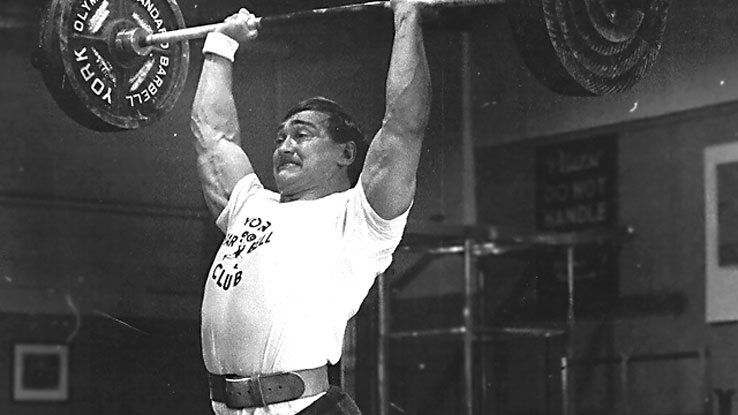

No longer an Olympic lift, the overhead press is still a popular event in strongman competitions and is also one of the best exercises for building upper body size and strength. However, unlike those pre-1972 Olympic lifters, you should not lean back when doing this exercise; that’s asking for injury!
In this guide, we reveal how to do the overhead press, its advantages, and benefits, how to fix your performance faults, and how to master this classic test of strength.
How To Do The Overhead Press
To enjoy all the benefits discussed elsewhere in this article, you must do overhead presses correctly. Not only will you get better results, but you’ll also reduce your risk of injury. Follow these steps to ensure that each and every rep you perform is as beneficial and safe as possible.
Note: these instructions are for a standing barbell overhead press. There are alternatives and variations to this movement of which we also included.
- Place a barbell in a squat rack or power cage set to just below shoulder-height. Step up to the bar and grasp it with an overhand, slightly wider than shoulder-width grip. You can use a full grip or a thumbless grip as preferred.
- Push your elbows forward and beneath the bar. Your forearms should be vertical when viewed from the side.
- Lift your chest and flare your lats. This will help stabilize your shoulders and upper back. Brace your abs to stabilize your lumbar spine.
- Using your legs, unrack the bar and take 1-2 steps back to give yourself room to work. Your feet should be around shoulder-width apart for balance.
- Bend your knees slightly for stability, but then keep them rigid. Do not use your legs to help you to help you lift the weight. This is a STRICT overhead press. Clench your glutes to increase lumbar stability.
- Lean back very slightly and press the weight straight up and overhead. As the bar passes your face, push your chest and shoulders forward again so that you are perfectly upright.
- Press the weight all the way up until your elbows are straight but not completely locked out. Locking your elbows puts a lot of stress on your joints, which, over time, could cause pain and injuries.
- After holding the bar aloft for a second or two, lower it back to your shoulders and repeat.
For the most part, overhead presses should be done with no added leg drive. Pushing with your legs takes tension off the target muscles. However, you can use your legs a little to complete the last rep or two of your set if necessary. This will help you get past the sticking point – usually the last half of the rep.
Overhead Press Advantages and Benefits
Now you know how to do an overhead press, it’s time to explain what makes this exercise so useful. After all, when it comes to pressing, most lifters focus on the bench press. The truth is that, as well as predating the bench press by more than a few centuries, the overhead press is potentially the more beneficial exercise.
Overhead presses work the following muscles:

Deltoids – the deltoid or shoulder muscles produce the majority of the force in overhead presses. All three deltoid heads are involved in this exercise; anterior, medial, and posterior. However, the anterior and medial heads are doing most of the work, while the posterior deltoid mostly functions as a stabilizer.
The functions of the deltoids are:
- Anterior – shoulder joint flexion, horizontal flexion, and medial rotation
- Medial – shoulder joint abduction
- Posterior – shoulder joint extension, horizontal extension, and external rotation
Triceps – located on the back of your upper arm, the triceps is a three-headed muscle responsible for the extension of your elbow and extension of the shoulder joint. For many exercisers, the triceps is the weak link when overhead pressing.
Upper and middle trapezius – the trapezius is the large trapezoid-shaped muscle of the upper back. The upper fibers work during overhead presses to stop your shoulders from being pushed downward. The middle fibers help pull your shoulders back to provide a stable platform from which to press. The lower fibers of the traps are not very active during this exercise.
Serratus anterior – this small but essential muscle helps keep your scapulae or shoulder blades flat against your rib cage. If you are very lean, it is visible between your upper ribs and has a serrated appearance, which is where it gets its name. In overhead presses, the serratus anterior works to stabilize your shoulder girdle.
Core – the collective term for the muscles that make up your midsection, the core is responsible for stabilizing your lumbar spine. Pressing as heavy weight overhead requires and develops excellent core strength (1).
Upper pecs – because you won’t be leaning back like an old-school Olympic lifter, your chest won’t get much of a workout during overhead presses. But the upper pecs do get a small but significant workout during this exercise. Your pecs, short for pectoralis major muscles, are the large muscles on the front of your upper torso.
The advantages and benefits of overhead presses include:
Build bigger shoulders – overhead presses are one of the best exercises for adding mass to your deltoids. They’re also an effective triceps and trap builder. If you want a bigger, more impressive upper body, you should include overhead presses in your hypertrophy workouts.
Beef up your triceps – while the overhead press is usually considered a shoulder exercise, your triceps get a good workout too. If you find triceps isolation exercises boring or that they hurt your elbows, it’s nice to know that you can rely on overheard presses to increase upper arm size and strength.
Functional strength – when it comes to building upper body strength, overhead presses are tough to beat. Bench presses can be useful, but when was the last time you had to lift a heavy weight while lying on your back? Overhead presses are much more functional, which means they have a bigger crossover to everyday and sporting movements.
A true test of strength – powerlifters often arch their lower backs to reduce the range of motion so they can lift heavier weights. This can mean that the person with the best arch lifts the most weight and not the strongest.
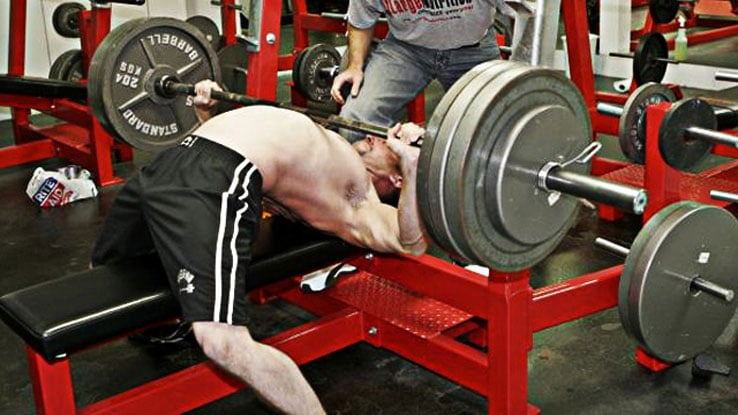

With overhead presses, there are fewer ways to “bend the rules,” and with no bench to support you, it’s a more valid test of whole-body strength. That’s one of the reasons you’ll see overhead presses in strongman competitions rather than bench presses.
You can overhead press a range of objects – you don’t have to limit yourself to barbell overhead presses. You can use dumbbells, sandbags, kettlebells, resistance bands, rocks, or barrels. You can even lift your training partner! With so many equipment options to choose from, there really is no excuse for not including overhead presses in your workouts.
Good for your posture – overhead presses force you to stand up straight and pull your shoulders down and back. You also need to keep your weight balanced evenly between your heel and forefoot, brace your abs, and look straight ahead. All of these factors can help improve your posture.
Good posture takes stress off things like your neck and lumbar spine and makes you look taller, slimmer, and more confident. In contrast, bench presses can contribute to poor posture.
A very safe exercise – if you fail to complete an overhead press, all you need to do is lower the bar back to your shoulders and then place it back in the rack. It’s quite hard to hurt yourself doing overhead presses.
In contrast, a failed bench press could (and often does!) result in serious injury, as the bar could crush your neck or chest. You don’t need spotters to do heavy overhead presses whereas, for bench presses, it’s a bad idea to use heavy weights on your own.
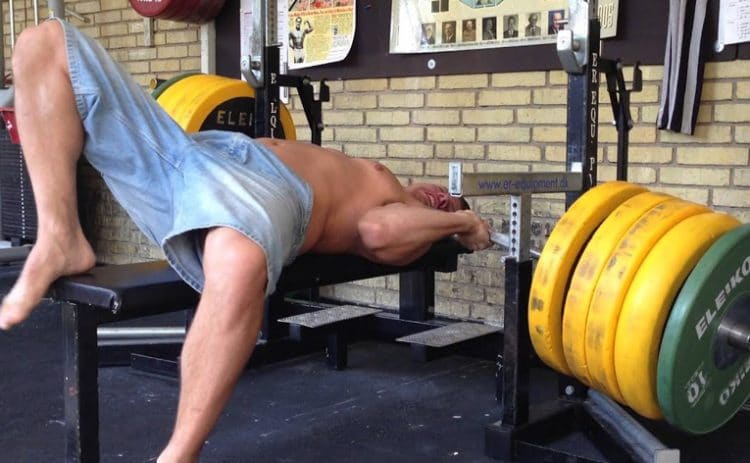

Self-forced reps – with the overhead press, it’s very easy to increase the intensity of your workouts. Simply do strict presses to failure and then use your legs to help you do a few more reps past your usual failure point. The result? Faster strength and hypertrophy gains.
Overhead Press Faults and How to Fix Them
To enjoy all of the benefits that overhead presses have to offer, you must perform them correctly. If you don’t, you could end up wasting a whole lot of time and energy and even get injured. Here are the most common overhead press faults and how to fix them.
Hyperextending your lumbar spine
A slight backward lean is part and parcel of overhead pressing. It’s what helps you lift your chest and avoid hitting your chin or nose with the bar as you press it upwards. However, leaning back too far puts a lot of stress on your lumbar intervertebral discs, facet joints, and spinal ligaments. Once injured, these structures take a long time to heal if they heal at all.
The keys to good posture during overhead presses are:
- A stronger core
- Good thoracic spine mobility
- Better pec and lat flexibility and shoulder mobility
- Not cheating by leaning back!
A steady diet of exercises like rollouts, get-ups, and single-arm farmer’s and waiter’s walks should suffice to build a stronger core. These exercises will teach you how to brace your abs and keep your lumbar spine locked in position.
A more mobile thoracic spine (T-spine) will allow you to lift your chest without leaning back from your lower back. Do this exercise daily to mobilize your upper back.
Kneel down and place your elbows on a box, chair, or bench. Holding a dowel, bend your arms and lower your chest down toward the floor. Ask a partner to gently push your upper arms together. Relax and allow your body weight to gently extend your thoracic spine.
Tight pecs and lats make it hard to press the bar straight up and overhead. Instead, you are more likely to push it forward. You’ll have to lean back to complete your lift, putting stress on your lumbar spine in the process.
There are lots of stretches you can do for your pecs and lats, but these are two of the best.
Pecs: Stand in a corner in a staggered stance. Raise your arms and place your forearms and hands vertically against the wall, so your elbows are level with your shoulders. Push your chest forward and between your arms. Hold this position for 30-60 seconds. Do this stretch 3-5 times a day to fix your flexibility.
Lats: Stand in front of a squat rack or any other waist-high anchor. Lean forward and grab it with your left hand. With your arm straight, push your hips over to the left until you feel a stretch up the side of your torso. Hold this position for 30-60 seconds. Do this stretch 3-5 times a day to fix your flexibility.
As for cheating, don’t use more weight than you can press using strict form. Save any “body English” for the last 1-2 reps of your final sets when you’re feeling exhausted but still want to pump out another rep or two.
Moving your feet
Once you unrack the bar and take 1-2 steps back, your feet should remain nailed to the floor until the end of your set. Moving your feet wastes energy and also destabilizes you, both of which will hurt your performance.
To avoid this fault, make sure your weight is distributed evenly between your forefoot and your heels. You should be able to wiggle your toes in your shoes, but the rest of your foot should be firmly planted on the floor.
Avoid wearing running shoes for overhead presses. They compress to absorb shock, which is useful when you’re pounding the pavement, but not so helpful during overhead presses. Hard-soled shoes are best.
Finally, push your feet apart to activate your deep hip stabilizers. Your feet won’t move, but trying to spread them apart will create a much more stable platform to press from. Keep your leg muscles tensed; your lower body must act like the bench in the bench press, i.e., solid and immovable.
The bar isn’t level
It’s very common to have one arm stronger than the other. Most people are left or right-side dominant. If you see that one side of the bar is higher than the other, put all of your mental energy into your weaker side. Block out all thoughts of your strong side and, instead, just think about the side that’s lagging behind. This will reinforce the mind-muscle connection and should help keep the bar level.
Also, make sure you are stood upright. Look at your hips and shoulders, and check that your weight is distributed evenly. Make any adjustments necessary to create the level platform you need for successful overhead presses.
If you have a significant left-to-right strength imbalance, switch from barbells to single-arm dumbbell presses. Train your weak side first, and then match your performance with your stronger side. This will help restore balance so that, when you return to barbell pressing, your limbs are more evenly developed.
Hands are too wide or too narrow
Hand position counts for a lot when you’re doing overhead presses. If your hands are too narrow, your triceps will end up doing more work than necessary. If your hands are too far apart, you’ll lose pressing power.
Your actual hand position depends on things like arm length and the width of your shoulders, so it’s impossible to tell you exactly where to grip the bar. However, as you look at your arms in the mirror, you should see that your forearms are vertical.
This is the most mechanically advantageous position and also provides the best range of motion for shoulder development. Experiment until you find the correct hand placement, and then commit it to memory. Use the knurling rings on your barbell for reference.
Programming for Hypertrophy
Just doing overhead presses regularly should help your shoulders and triceps grow, but you’ll get better results if you train specifically for hypertrophy. Apply the following information to your overhead press workouts to make them as productive as possible:
Use the right weight – for hypertrophy, you should train with weights between 67-85% of your one-repetition maximum, or 1RM for short. You can test for your one 1RM by doing a series of progressively heavier single reps or estimate it using an online 1RM calculator.
Using the correct weight will keep you in the appropriate repetition range for hypertrophy – 6-12 reps. It’s okay to stray from this range occasionally, but you’ll build more muscle if most of your workouts involve the 6-12 rep range.
Train with intensity – muscles don’t want to grow! You have to badger, challenge, and bully them into getting bigger and stronger. That means you should shoulder press to failure if you want your delts to grow. Make sure you rep out until you are unable to complete any more reps. Then, to increase your workout intensity even more, use your legs to help you push the weight up for 1-2 more reps.
Try a training system – straight sets, such as three sets of 12 reps to failure, can produce good results but, after a while, your body will become accustomed to such a plain vanilla workout approach.
Liven up your workouts and bust through training plateaus by using a training system. Training systems are recognized methods designed to increase workout intensity. Good training systems that work well with shoulder presses include:
Rest/pause: rep out to failure, rest 10-15 seconds, and then do a couple more reps. Rest once more, and then do a final 1-2 reps.
Pre-exhaust: do a deltoid isolation exercise immediately before overhead presses, e.g., dumbbell lateral raises.
Post-exhaust: do a deltoid isolation exercise immediately after overhead presses, e.g., front raises.
Read more about these and other training systems in this article!
Use plenty of variation – as good as the standing barbell overhead press is, it’s just one version of this type of exercise. Keep your workouts fresh and productive by using the variations listed in the next section. They’re all similarly beneficial but also different enough to challenge your muscles in a new way to maintain your gains.
Stretch out your pecs and lats between sets of overhead presses – tight pecs and lats can inhibit your overhead press performance, making this exercise less effective and harder to perform. Use your rest periods to stretch these muscles so that antagonistic muscle tightness does not impede your performance.
Overhead Press Variations and Alternatives
The overhead press is a fantastic exercise, but that doesn’t mean it’s the only exercise you can use to build bigger shoulders, traps, and triceps. In fact, it’s just one of many movements you can use to train your upper body. Use the following variations and alternatives to keep your workouts productive and interesting.
1. Seated barbell press
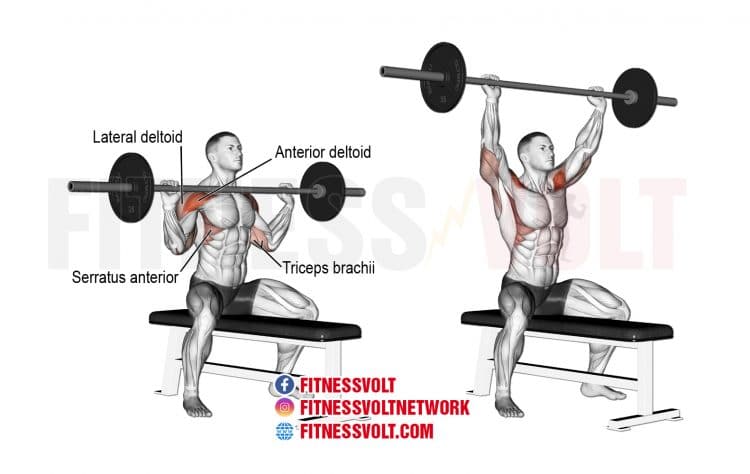
Standing shoulder presses force you to use your core to keep your lumbar spine stable. While this is a valuable benefit, it can also be a disadvantage as you may find your core fatigues before your deltoids and triceps.
Firstly, you should work on your core strength to prevent this problem. You can also do seated overhead presses so the bench will support your back, leaving you free to focus on lifting the weight.
2. Z-press
The Z-press is another seated barbell press, but this time you need to use your core even more to stabilize your spine. This move teaches you to maintain perfect pressing posture because, if you lean back, there is nothing to hold you up.
How to do it:
- Sit on the floor with your legs straight and spread wide for balance. Adopt a tall posture. Hold a barbell across your shoulders as you would for regular overhead presses.
- With your core braced, and without leaning forward or back, press the bar up and overhead.
- Lower the bar back to your shoulders and repeat.
- If you have tight hamstrings and cannot keep your legs out straight, sit on a 4 to 8-inch platform. This will reduce the angle of your hips and allow you to sit with straight knees.
3. Bradford press
The Bradford press is named after US Olympic weightlifter Jim Bradford, who was known for his huge shoulders and impressive overhead pressing strength.
This is a slightly controversial exercise because it involves lowering the bar behind your head. This may increase your risk of shoulder injury, especially if you have tight pecs or anterior deltoids. Use this exercise with caution or avoid it completely if you have a history of shoulder pain.
How to do it:
- Set up as usual for barbell overhead presses. With your abs braced, press the bar up.
- As it approaches the top of your head, lift the bar over and then behind your head to the back of your neck. Do not raise the bar higher; it should just clear the top of your head.
- Press the bar from your neck back over your head and then lower it to your shoulders.
- That’s one rep; keep going!
- This exercise can be done seated or standing. It works best with light to moderate weights and medium to high reps. Chase the pump!
4. Javelin press
Most barbell exercises are bilateral, which means they involve two limbs working together. The javelin press is a unilateral or one-limbed barbell exercise. It’s a good move for developing core strength and shoulder stability. However, it’s not easy, so start out with an empty barbell if you’ve never done this exercise before.
How to do it:
- Place your barbell in a shoulder-height squat rack. Stand sideways on to the bar and grip the center using a neutral grip. Brace your abs and unrack the bar.
- Keeping your hips and shoulders level, press the weight up and overhead to arms’ length. Do not allow the bar to turn or tilt.
- Lower the bar back to your shoulder and repeat.
- Rerack the bar and then swap sides.
5. Push-press
Your legs should be rigid in the classic barbell overhead press. This ensures that your shoulders, triceps, and traps do all of the work. With the push press, you purposely use your legs to help you drive the weight up. This will allow you to use heavier weights, which is useful for increasing strength. Also, if you lower the bar slowly, you can expose your muscles to greater tension, resulting in increased hypertrophy.
How to do it:
- Set up as usual for your overhead press, standing with your feet about hip-width apart. Brace your core.
- Bend your knees and descend into a quarter-depth squat.
- Powerfully extend your legs and use this momentum to help you push the weight up and overhead.
- Lower the weight under control to your shoulders and repeat.
6. Clean and press
The clean and press is a simplified version of the clean and jerk, one of the events in Olympic lifting. It also provides an alternative way to start your overhead presses if you don’t have access to a squat rack or power cage.
You can do a clean and strict barbell overhead press with no leg drive, or a clean and push-press.
Of course, to do either of these exercises, you need to master the power clean. Learn how to do this powerful exercise in this guide.
7. Dumbbell overhead press
Using dumbbells for overhead presses allows you to train your arms independently and keep your upper arms out and back instead of in front of your torso. Many lifters find this position more comfortable. The main disadvantage of dumbbell overhead presses is that it can be hard to get heavy weights into the right starting position. With a barbell, you can just place it in a squat rack.
There are several dumbbell overhead press variations you can try, including:
You can also use kettlebells in place of dumbbells.
8. Pike push-ups
No barbell? No dumbbells? No problem! Pike push-ups involve a very similar muscle and joint action to overhead presses, but you don’t need anything apart from your bodyweight to do them.
How to do it:
- Squat down and place your hands flat on the floor a little wider than shoulder-width apart. Walk your feet back and into the push-up position. Lift your butt into the air, so your body resembles an inverted V.
- Push your head down between your arms. Try not to round your lower back.
- Bend your arms and lower your forehead to the floor. Descend smoothly and under control to avoid banging your head.
- Push yourself back up and repeat.
- Make this exercise harder by placing your hands on blocks to increase your range of motion or by putting your feet on a step or bench to put more weight on your hands.
9. Handstand push-ups
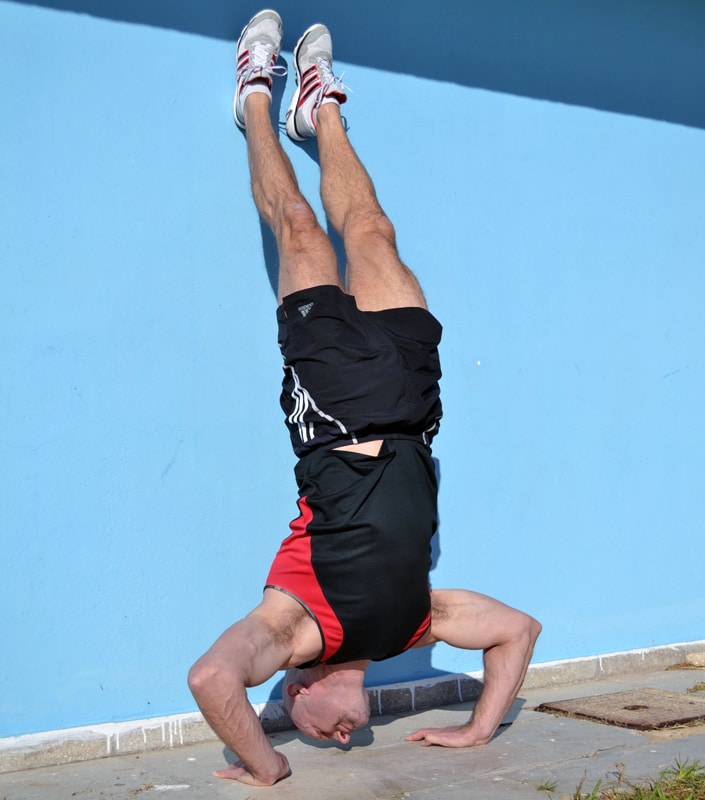
If you have mastered pike push-ups, you may be ready for another bodyweight shoulder press alternative – handstand push-ups. This CrossFit favorite is a tough exercise, especially if you are on the heavy side. But, for overloading your shoulders and triceps with just your bodyweight, it’s hard to beat.
How to do it:
- Squat down and place your hands about 12” away from a smooth wall. Your hands should be slightly wider than shoulder-width apart, fingers pointing forward.
- Kick yourself up into a handstand position and rest your feet against the wall. Brace your abs and look down toward the floor.
- Bend your arms and lower your forehead down to the floor. Descend slowly to avoid banging your head.
- Extend your arms and press yourself back up.
- Make this exercise harder by placing your hands on blocks to increase your range of motion.
10. Shoulder press machine
A lot of fitness coaches are very opposed to resistance machines. They say they aren’t natural or functional. However, while it IS true that machines like the shoulder press involve very little balance or coordination, that can be a good thing when you are training for hypertrophy. Because your movement and the weights are guided, you are free to focus 100% on lifting and lowering, and you can train to complete failure too.
How to do it:
- Adjust the seat so that your shoulders are level with the handles. Sit on the machine and grab the handgrips.
- Press the weights up and overhead to arms’ length. Do not lock your elbows.
- Lower the weights back down but do not allow them to touch.
- Most machines have parallel and straight handles, so use the one you prefer.
Assistance Exercises to Improve your Overhead Press Performance
Just doing shoulder presses regularly should make you better at doing them. But, if you want to improve your performance faster, there are some exercises and methods you can use that will have a specific performance-boosting effect.
1. Skull crushers
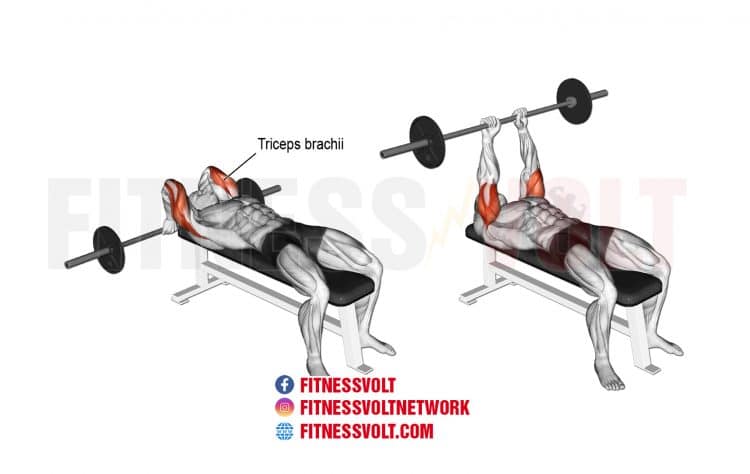

Overhead presses are usually classified as a shoulder exercise, but for many lifters, it’s the triceps that seem to be doing most of the work. If you feel the backs of your arms more than your delts, you may have weak triceps.
There are lots of good triceps exercises you can do, but barbell or EZ bar skull crushers are one of the most useful. Once you have done skull crushers to failure, switch to close grip bench presses to really fry your triceps.
No weights? You can also do bodyweight skull crushers to beef up your triceps.
2. Partial presses
Partial presses allow you to lift more weight than usual. This is a useful exercise for increasing deltoid and triceps strength. Set the J-hooks in your squat rack to about head height and press the bar up from there. The shorter your range of movement is, the heavier you’ll be able to go. Partial presses can be done seated or standing.
3. Overhead shrugs
The upper traps play an important role in overhead presses, and while things like regular shrugs are useful for strengthening this muscle, overhead shrugs are a lot more movement-specific.
How to do it:
- Press and hold a barbell overhead. Straighten, but don’t lock your elbows.
- Shrug your shoulders upward as though you were trying to touch the ceiling with your barbell.
- Lower your shoulders and repeat.
- This exercise can be performed seated or standing, and also with dumbbells.
Overhead Press Hypertrophy – Wrapping Up
If you want bigger, stronger shoulders and triceps, you need to build your upper body workouts around overhead presses. No other type of exercise will develop your shoulders better!
The bench press might be the king of pressing movements, but while it is a fine exercise, most lifters would benefit from more overhead work. As an added benefit, increasing your overhead press invariably leads to increased bench press performance, making it a real training twofer.
Whether you are an experienced lifter, or a newbie just starting out, make sure that overhead presses are part of your workouts and that you do them correctly. Use the information in this guide to maximize your overhead pressing performance.
References:
1 – PubMed: Effect of surface stability on core muscle activity for dynamic resistance exercises (https://pubmed.ncbi.nlm.nih.gov/19417231/)
